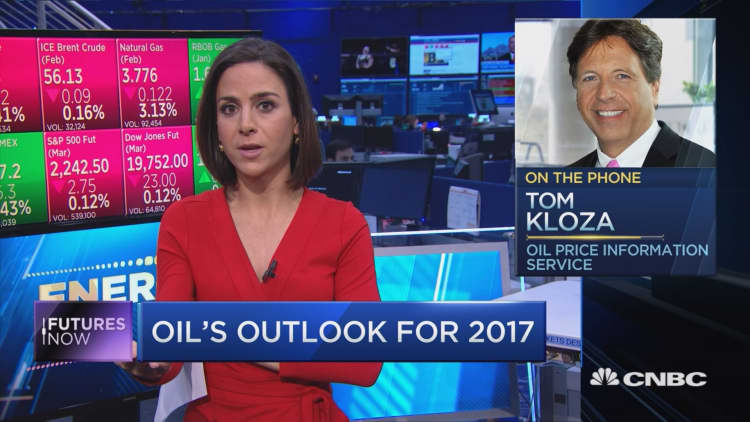
After a year of relatively cheap driving, gasoline prices are creeping higher and consumers could even see a price spike by mid-2017.
Prices should be up in the new year, in large part because of higher oil prices but also because of the growing export market for U.S.-refined gasoline. Last week, the U.S. exported a record 1.1 million barrels a day, most likely to Mexico and South America.
Some experts say there could be a temporary jump of 20 percent or more in the national average at some point in the spring when driving season picks up. Demand is softer in the winter months, but prices could get a bit higher through January and February.
Gasoline has already begun its climb. After holding below $2.30 per gallon of unleaded for 200 straight days, the national average for gasoline crossed that level Thursday. It was at $2.31 per gallon Friday, according to AAA. Gasoline futures, meanwhile, have risen in 9 of the last 11 sessions.
"There will be a spike and everyone will be talking about it and it will probably be between Easter and Memorial Day," said Tom Kloza, global head of energy analysis at Oil Price Information Service.
That spike could take the price at the pump temporarily to a national average of $2.75 to $2.85 per gallon, he said. Gasoline prices averaged about $2.12 per gallon this year, and the 2017 national average could range between $2.399 and $2.519 for unleaded, Kloza said.
Gas prices were about $2.40 in 2015, but higher for several years before that with the average $3.34 in 2014. There were some super low prices in the U.S. in 2016, with some drivers paying around $1.60 per gallon, but there were also price spikes, including in the Southeast when the Colonial pipe line was temporarily shut down.
"It's going to be front-end loaded. We're going to see a spike and then we'll see prices ease from that spike," Kloza said of 2017 pump prices. Some places, like Connecticut, California and Pennsylvania could temporarily see prices over $3 per gallon.
"That forecast depends on no hurricane and no border tax. The border tax is a new wild card that I just don't think is going to get passed," he said. The border tax is a congressional proposal to tax goods and services coming into the U.S. but not tax exports. The refining industry is opposed to it as it could be applied to oil imports.
"Part of the national average is being driven higher by the New Jersey gas tax and other taxes that will kick in starting New Year's," said John Kilduff of Again Capital. He said a handful of states are raising taxes on gasoline, including Pennsylvania and Michigan.
Kilduff said he sees gasoline prices trending higher just because of the rise in crude prices, up 45 percent in 2016 and 20 percent just since the election. The most recent runup is credited to a production deal between OPEC and non-OPEC producers, like Russia.
Whether gasoline will spike, however, is not clear, he said. "It has the potential, given all the exports," said Kilduff. "That's been the change, especially the sales to Mexico. What's going to happen to Venezuela is anybody's guess and they have refinery capacity that would be a problem if it's lost for any period of time."
Kloza said supply will also be impacted when refineries take capacity offline for maintenance ahead of the switch to summer fuels. About 30 percent of capacity will be affected by the turnaround, he said.
The exports should also support prices, he said. "It's a double-edged sword. It is the big difference maker going into 2017, compared to 2016," said Kloza.
The U.S. produces between 9 million and 10 million barrels of gasoline a day. Last week, U.S. consumers used about 9.3 million barrels a day of gasoline, while refiners also exported a record 1.1 million barrels a day.
The U.S. also imports gasoline to the East Coast from Europe, the Caribbean and Venezuela. That amounted to 434,000 barrels a day last week, down by about half of what was imported last year at the same time.
Kloza said the exports helped with a glut of gasoline in the U.S. "In the summertime, we got to where we made more than 10 million barrels a day of gasoline and manufactured more than 5 million barrels a day of distillates. That was a big deal. ... We thought you'd have 9 [million] and 4 [million] for domestic demand. If it weren't for gasoline exports — and the highest months can be December and January — we'd be looking at matching that big inventory buildup we had last January," he said.
Gasoline supplies surged in early 2016, to a record 258 million barrels.
Kloza said Mexico and South America are the key destinations for U.S. gasoline and diesel fuel. He expects Mexico is now importing about 500,000 barrels a day of U.S. gasoline. Mexico also exports about 500,000 barrels of oil per day to the U.S. In September, government data show Mexico imported 390,000 barrels a day. Detailed December data will be available in several months.
"We're the bread basket and the refiner to the world," said Kilduff. The U.S. also exported 1.4 million barrels a day of diesel fuel last week.
Kilduff said it's more difficult than usual to predict where oil and gasoline prices are heading in 2017.
"There's wild cards out there. Does the OPEC production deal hold together? Do the frackers come back in a big way? This is a tough year to call. In my opinion, it's the hardest one to call in a while because of all the policy uncertainty," he said. "The only thing that's supportive is we don't have an aggressive Saudi posture any longer. That's a big change."
Oil prices cratered in February 2016, after 14 months of a new Saudi Arabia-driven OPEC policy to let the market set prices. That policy led to a giant crude surplus which ultimately became a refined product glut as well.
As for gasoline, Kilduff said if margins improve, refiners will go full tilt. "They'll ramp up productive capacity. It's going to be a very up-and-down year," he said.



